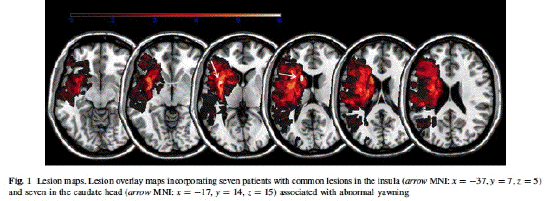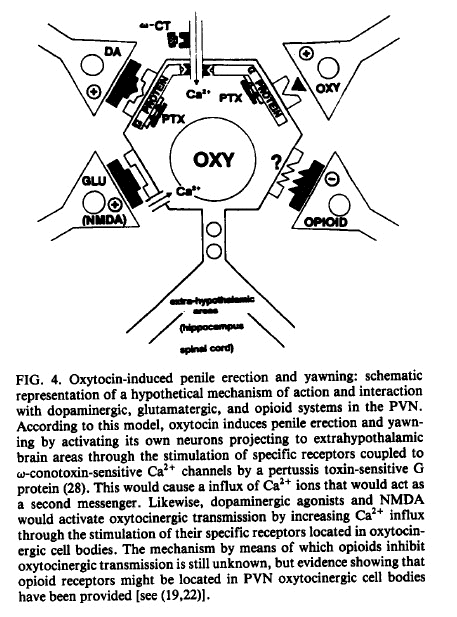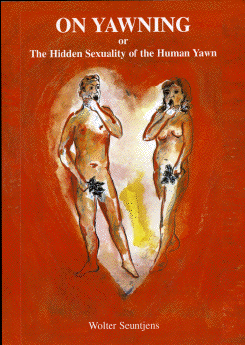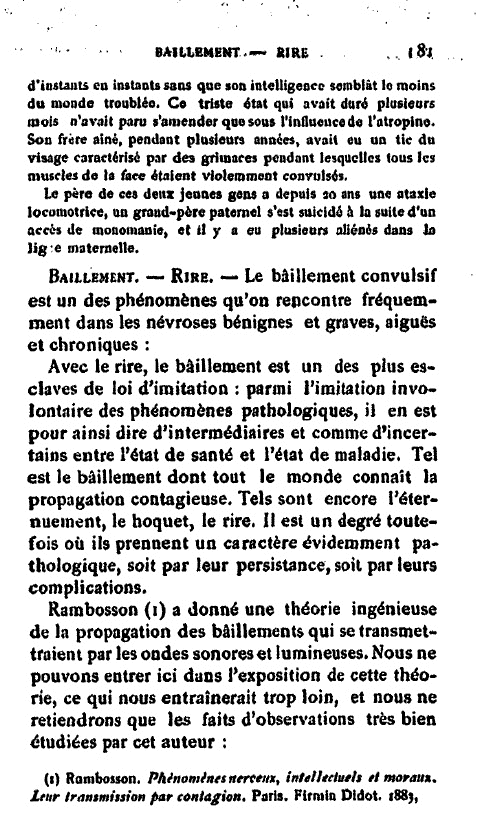
samedi 1mars 2014 la lettre d'information du site baillement.com N°127 Si vous ne voyez pas les images, cliquez ici pour lire cette lettre dans votre navigateur. If you cannot see pictures below, to view the email in your web browser click here baillement.com est libre d'accès, base documentaire pour comprendre, chercher, travailler
-
Insular and caudate lesions release - abnormal yawning in stroke patients
- Krestel H, Weisstanner C, Hess CW, Bassetti CL, Nirkko A, Wiest R.
- Brain Struct Funct
- 2014
- Yawning and Stroke
- Bâillements et AVC
-
Stroke in the insula and the caudate nucleus correlates with the period with abnormal yawning - Abnormal yawning is an underappreciated phenomenon in patients with ischemic stroke. The authors aimed at identifying frequently affected core regions in the supratentorial brain of stroke patients with abnormal yawning and contributing to the anatomical network concept of yawning control. Ten patients with acute anterior circulation stroke and ³3 yawns/15 min without obvious cause were analyzed. The NIH stroke scale (NIHSS), Glasgow Coma Scale (GCS), symptom onset, period with abnormal yawning, blood oxygen saturation, glucose, body temperature, blood pressure, heart rate, and modified Rankin scale (mRS) were assessed for all patients.
- MRI lesion maps were segmented on diffusion-weighted images, spatially normalized, and the extent of overlap between the different stroke patterns was determined. Correlations between the period with abnormal yawning and the apparent diffusion coefficient (ADC) in the overlapping regions, total stroke volume, NIHSS and mRS were performed. Periods in which patients presented with episodes of abnormal yawning lasted on average for 58 h. Average GCS, NIHSS, and mRS scores were 12.6, 11.6, and 3.5, respectively. Clinical parameters were within normal limits. Ischemic brain lesions overlapped in nine out of ten patients: in seven patients in the insula and in seven in the caudate nucleus. The decrease of the ADC within the lesions correlated with the period with abnormal yawing (r = -0.76, Bonferroni-corrected p = 0.02).
- The stroke lesion intensity of the common overlapping regions in the insula and the caudate nucleus correlates with the period with abnormal yawning. The insula might be the long sought-after brain region for serotonin-mediated yawning.

- Une période de bâillements anormaux au cours d'un AVC est corrélée à une atteinte de l'insula et du noyau caudé
- Les bâillements anormaux sont un phénomène dont la fréquence est sous-estimée chez les patients affectés d'un AVC ischémique.
- Les auteurs ont cherché à identifier les circuits neuronaux touchés chez ces patients, espérant ainsi contribuer à l'identification des réseaux anatomiques à l'origine des bâillements.
- Dix patients avec AVC aigus et bâillant plus de 3 fois en 15 mn, sans cause évidente, ont été explorés.
- Le NIH Stroke Scale (NIHSS), l'échelle de Glasgow (GCS), l'apparition des symptômes, la période avec des bâillements anormaux, la saturation en oxygène du sang, le glucose, la température corporelle, la pression artérielle, le rythme cardiaque, et l'échelle de Rankin modifiée (MRS) ont été évalués pour tous les patients.
- Les zones lésées visibles en IRM ont été étudiées par différentes techniques permettant une pondération et un superposition des images des différents patients.
- Les périodes au cours desquelles les patients ont présenté des épisodes de bâillements anormaux ont duré en moyenne 58 h. Les GCS, NIHSS, et MRS scores moyens étaient de 12,6, 11,6 et 3,5 respectivement. Les paramètres cliniques étaient dans des limites normales. Les lésions cérébrales ischémiques sont superposables pour neuf des dix patients: chez sept patients au niveau de l'insula et sept au niveau du noyau caudé.
-
Penile erection and yawning induced by paraventricular NMDA injection in male rats are mediated by oxytocin - Melis MR, Stancampiano R, Argiolas A.
- Pharmacol Biochem Behav
- 1994;48(1):203-207
- Tous les travaux de MR Melis & A Argiolas
- Tous les travaux de M Eguibar & G Holmgren
-
NMDA induces penile erection and yawning when injected in the PVN - Penile erection and yawning are two distinct behavioral patterns that often occur concomitantly under certain physiological and experimental conditions. Among substances that induce both penile erection and yawning, dopaminergic agonists, oxytocin and adrenocorticotropin (ACTH) are certainly the most widely known.
- NMDA induces penile erection and yawning when injected in the PVN. This suggests that oxytocinergic neurons mediating these responses are also under the control of excitatory amino acids in addition to other neurotransmitters, i.e., dopamine, opioid peptides, and oxytocin itself, as already described for PVN oxytocinergic magnocellular neurons. In particular, dopamine, glutamic acid, and oxytocin itself seem to have a facilitatory and opioids an inhibitory role in the expression of penile erection and yawning.
-

- Le NMDA induit érection pénienne et bâillements quand il est injecté dans le noyau paraventriculaire de l'hypothalamus
- L'érection pénienne et le bâillement sont deux comportements distincts qui se produisent souvent de façon simultanée, dans certaines conditions physiologiques et expérimentales. Parmi les substances qui induisent à la fois l'érection et le bâillement, les agonistes dopaminergiques, l'ocytocine et adrénocorticotropine (ACTH) sont certainement les plus connus.
- Le NMDA induit une érection pénienne et le bâillement lorsqu'il est injecté dans le PVN. Cela donne à penser que les neurones oxytocinergiques médiateurs de ces réponses sont également sous le contrôle d'acides aminés excitateurs ainsi que d'autres neurotransmetteurs, à savoir, la dopamine, les peptides opioïdes, l'oxytocine et le NMDA lui-même, comme cela déjà été décrit pour les neurones magnocellulaires oxytocinergiques du PVN. En particulier, la dopamine, l'acide glutamique, et l'ocytocine se semblent avoir un rôle de facilitation et les opioïdes un rôle inhibiteur dans l'expression de l'érection pénienne et le bâillement.
-
Restricted access to standard or high fat chow alters sensitivity of rats to the 5-HT2A/2C receptor agonist 1-(2,5-dimethoxy-4-methylphenyl)-2-aminopropane. - Serafine KM, France CP.
- Behav Pharmacol
- 2014;25(1):44-52
-
Feeding conditions can impact sensitivity to drugs acting on dopamine and serotonin systems and thus affect yawning's frequency. - Feeding conditions can impact sensitivity to drugs acting on dopamine receptors; less is known about the impact of feeding conditions on the effects of drugs acting on serotonin (5-HT) receptors.
- This study examined the effects of feeding conditions on sensitivity to the direct-acting 5-HT2A/2C receptor agonist 1-(2,5-dimethoxy-4-methylphenyl)-2-aminopropane (DOM; 0.1-3.2 mg/kg) and the direct-acting dopamine D3/D2 receptor agonist quinpirole (0.0032-0.32 mg/kg). Male Sprague-Dawley rats had free access (11 weeks), followed by restricted access (6 weeks), to high fat (34.3%, n=8) or standard (5.7% fat; n=7) chow.
- Rats eating high fat chow became insulin resistant and gained more weight than rats eating standard chow. Free access to high fat chow did not alter sensitivity to DOM-induced head twitch but increased sensitivity to quinpirole-induced yawning.
- Restricting access to high fat or standard chow shifted the DOM-induced head twitch dose-response curve to the right and shifted the quinpirole-induced yawning dose-response curve downward in both groups of rats.
- Some drugs of abuse and many therapeutic drugs act on 5-HT and dopamine systems; these results show that feeding conditions impact sensitivity to drugs acting on these systems, thereby possibly affecting vulnerability to abuse, as well as the therapeutic effectiveness of drugs.
- -Baladi MG, Newman AH, France CP Dopamine D3 receptors mediate the discriminative stimulus effects of quinpirole in free-feeding rats. J Pharmacol Exp Ther. 2010;332(1):308-315
- -Baladi MG, Newman AH, France CP. Influence of body weight and type of chow on the sensitivity of rats to the behavioral effects of the direct-acting dopamine-receptor agonist quinpirole.Psychopharmacology (Berl). 2011;217:573&endash;585
- -Baladi MG, Thomas YM, France CP. Sensitivity to apomorphine-induced yawning and hypothermia in rats eating standard or high-fat chow. Psychopharmacology (Berl). 2012;222(1):27-36
- L'alimentation modifie la sensibilité aux drogues agissant sur les systèmes dopaminergique et sérotononergique et modifie ainsi la fréquence des bâillements
- La nature des aliments ingérés modifie la sensiblité aux drogues agissant sur le système dopaminergique. Les connaissances de l'impact de l'alimentation sur le système sérotoninergique sont plus ténues. Les rats soumis à une alimentation riche en graisse deviennent résistants à l'insuline et obèses. Ils présentent une sensibilié accrue aux bâillement induits par le quinpirole (agoniste des récepteurs D2/D3 à la dopamine).
- Des drogues illicites et de nombreux médicaments agissent sur les systèmes dopaminergique et sérotoninergique. Le type d'alimentation influence et affecte la sensibilité/ vulnérabilité aux drogues, affectant les effets recherchés ou observés comme les bâillements. Ces travaux en sont une preuve.
-
On Yawning - or the hidden sexuality of the human yawn
- Wolter Seuntjens

-
La folie chez les enfants - Paul Moreau de Tours (1844-1908)
- 1888
- Contemporain de DM. Bourneville, il écrit le premier ouvrage de pédopsychiatrie dont sont extraites ces pages
- Propagation à distance des affections et des phénomènes nerveux expressifs
- Rambosson J.
- 1880
-
Man stretches whilst yawning - around 1830
- author unknown
- voir / see
- Joseph Ducreux
- 1735 - 1802
-
Autres documents mis en ligne ce mois-ci :
Résultats du sondageau 28 février 2014 Recherche par mot du site
-
Nombre de questionnaires remplis : 6725 - Combien de fois bâillez-vous par jour ? <5 = 23,2%.. 5-10 = 22,2%.. 10-15 = 15,2%.. 15-20 = 10,9%.. >20 = 28,5%
- Ressentez-vous des baillements excessifs ?
- 51,6% = non, tant mieux
- 37,5% = oui et je ne sais pas pouquoi
- 9% = oui et je prends des antidépresseurs
- 1,0% = oui et je prends des anti-épileptiques
- 6,3% = oui et je prends d'autres médicaments
- 2,3% = oui et j 'ai des troubles neurologiques
- 2,4% = oui et j 'ai des troubles hormonaux
- 1,4% = oui et j 'ai des tics moteurs
- 1,6% = oui et j 'ai des tocs
- déclenchez-vous facilement le bâillement d'autrui ? 74,3%
- êtes-vous sensible au bâillement d'autrui ? 68,2%
- Ludo
van Bogaert
1877-1989
- The significance of a discovery can only be appreciated in the light of our knowledge, in this precise sphere, at the time of its occurrence. Its impact can be foretold only from the light that it throws on the understanding of a confused or new matter. It is more precisely sensed by the boost given to the analysis of neighbouring, different but closely related, themes.
- La signification d'une découverte ne peut se juger qu'à la lumière de ce qu'étaient nos connaissances, dans ce domaine précis, au moment où elle se produisit. Sa portée ne peut se deviner qu'à la clarté qu'elle jette dans la compréhension d'une question confuse ou inédite. Elle prend tout son sens, plus exactement encore, en observant l'impulsion qu'elle donne à l'analyse de thèmes voisins, différents mais connexes.
baillement.com baillement.info yawning.info écrits et réalisés par le Dr Walusinski
lire les lettres précédentes d'information du site tapez votre email - give your email pour ne plus recevoir cette lettre - to unsubscribe to the website's letter:



